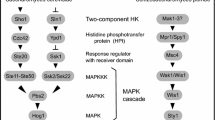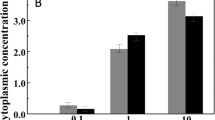Abstract
Halophilic organisms living in saline environments like salt lakes, coastal lagoons or man-made salterns are challenged by two stress factors, the high inorganic ion concentration and the low water potential. Prokaryotes have developed two principal mechanisms to cope with these stress factors and counteract the outflow of cytoplasmic water, namely, the “salt-in-cytoplasm” mechanism and the organic-osmolyte mechanism.
Access this chapter
Tax calculation will be finalised at checkout
Purchases are for personal use only
Preview
Unable to display preview. Download preview PDF.
Similar content being viewed by others
References
Brown A.D. (1976) Microbial water stress. Bacteriol Rev 40: 803 - 846
Canovas D, Vargas C, Csonka L.N., Ventosa A, Nieto J.J. (1996) Osmoprotectants in Halomonas elongata: high-affinity betaine transport system and choline-betaine pathway. J Bacteriol 178: 7221 - 7226
Dennis P.P., Shimmin L.C. (1997) Evolutionary divergence and salinity-mediated selection in halophilic Archaea. Microbiol Mol Biol Rev 61: 90 - 104
Dinnbier U, Limpinsel E, Schmid R, Bakker E.P. (1988) Transient accumulation of potassium glutamate and its replacement by trehalose during adaptation of growing cells of Escherichia coli K-12 to elevated sodium chloride concentrations. Arch Microbiol 150: 348 - 357
Driessen A.J.M., Rosen B.P., Konings W.N. (2000) Diversity of transport mechanisms: common structural principles. TIBS 25: 397 - 401
Forward J.A., Behrendt M.C., Wyborn N.R., Cross R, Kelly D.J. (1997) TRAP transporter: a new family of periplasmic solute transport systems encoded by the dctPQM genes of Rhodobacter capsulatus and by homologs in diverse gram-negative bacteria. J Bacteriol 179: 5482 - 5493
Galinski E.A. (1995) Osmoadaptation in Bacteria. Adv Microb Physiol 37: 273 - 328
Grammann K, Volke A, Kunte H.J. (2002) New type of osmoregulated solute transporter identified in halophilic members of the Bacteria domain: TRAP transporter TeaABC mediates the uptake of ectoine and hydroxyectoine in Halomonas elongata DSM 2581T. J Bacteriol 184: 3078 - 3085
Hagemann M, Richter S, Mikkat S (1997) The ggtA gene encodes a subunit of the transport system for the osmoprotective compound glucosylglycerol in Synechocystis sp. strain PCC 6803. J Bacteriol 179: 714 - 720
Jacobs M.H.J., Heide T, Driessen A.J.M., Konings W.N. (1996) Glutamate transport in Rhodobacter sphaeroides is mediated by a novel binding protein-dependent secondary transport system. Proc Natl Acad Sci USA 93: 12786 - 12790
Jebbar M, Talibart R, Gloux K, Bernard T, Blanco C (1992) Osmoprotection of Escherichia coli by ectoine: uptake and accumulation characteristics. J Bacteriol 174: 5027 - 5035
Kempf B, Bremer E (1998) Uptake and synthesis of compatible solutes as microbial stress responses to high-osmolality environments. Arch Microbiol 170: 319 - 330
Kunte H.J., Galinski E.A. (1995) Transposon mutagenesis in halophilic eubacteria: conjugal transfer and insertion of transposon Tn5 and Tn1732 in Halomonas elongata. FEMS Microbiol Lett 128: 293 - 299
Kunte H.J., Crane R.A., Culham D.E., Richmond D, Wood J.M. (1999) Protein ProQ influences osmotic activation of compatible solute transporter ProP in Escherichia coli K-12. J Bacteriol 181: 1537 - 1543
Kunte H.J., Galinski E.A., Grammann K, Volke A, Bestvater T (200 1) Verfahren zur Gewinnung von Wertstoffen aus Organismen durch Beeinflussung/Beeinträchtigung der zelleigenen Transportsysteme für diese Wertstoffe bzw. durch Verwendung von Produktionsstämmen, denen besagte Transportsysteme fehlen. German Patent Application DE 101 14 189. 0
Lai M.-C., Yang D.-R., Chuang M.-J. (1999) Regulatory factors associated with synthesis of the osmolyte glycine betaine in the halophilic methanoarchaeon Methanohalophilus portucalensis. Appl Environ Microbiol 65: 828 - 833
Lanyi J.K. (1974) Salt-dependent properties of proteins from extremely halophilic bacteria. Bacteriol Rev 38: 272 - 290
Mackay M.A., Norton R.S., Borowitzka L.J. (1984) Organic osmoregulatory solutes in cyanobacteria. J Gen Microbiol 130: 2177 - 2191
Mellies J, Brems R, Villarejo M (1994) The Escherichia coli proU promotor element and its contribution to osmotically signalled transcription activation. J Bacteriol 176: 3638 - 3645
Nyström T, Neidhardt F.C. (1996) Effects of overproducing the Universal Stress Protein UspA, in Echerichia coli K-12. J Bacteriol 178: 927 - 930
Oren A (1999) Bioenergetic aspects of halophilism. Microbiol Mol Biol Rev 63: 334 - 348
Oren A, Mana L (2002) Amino acid composition of bulk protein and salt relationships of selected enzymes of Salinibacter ruber, an extremely halophilic bacterium. Extremophiles 6: 217 - 223
Peter H, Weil B, Burkovski A, Krämer R, Morbach S (1998) Corynebacterium glutamicum is equipped with four secondary carriers for compatible solutes: identification, sequencing and characterization of the proline/ectoine uptake system, ProP, and the ectoine/proline/glycine betaine carrier, EctP. J Bacteriol 180: 6005-6012
Rabus R, Jack D.L., Kelly D.J., Saier M.H. (1999) TRAP transporters: an ancient family of extracytoplasmic solute-receptor-dependent secondary transporters. Microbiology 145: 3431 - 3445
Racher K.I., Voegele R.T., Marshall E.V., Culham D.E., Wood J.M., Jung H, Bacon M, Cairns M.T., Ferguson S.M., Liang W.-J., Henderson P.J.F., White G, Hallett F.R. (1999) Purification and reconstitution of an osmosensor: transporter ProP of Escherichia coli senses and responds to osmotic shifts. Biochemistry 38: 1676 - 1648
Rengpipat S, Lowe S.E., Zeikus J.G. (1988) Effect of extreme salt concentration on the physiology and biochemistry of Halobacteroides acetoethylicus. J Bacteriol 170: 3065 - 3071
Robert H, Le Marrec C, Blanco C, Jebbar M (2000) Glycine betaine, carnitine, and choline enhance salinity tolerance and prevent the accumulation of sodium to a level inhibiting growth to Tetragenococcus halophila.Appl Environ Microbiol 66: 509 - 51
Rübenhagen R, Rönsch H, Jung H, Krämer R, Morbach S (2000) Osmosensor and osmoregulator properties of the betaine carrier BetP from the Corynebacterium glutamicum in proteoliposomes. J Biol Chem 275: 735 - 741
Saier M.H. (1994) Computer-aided analyses of transport protein sequences: gleaning evidence concerning function, structure, biogenesis, and evolution. Microbiol Rev 58: 71 - 93
Severin J, Wohlfarth A, Galinski E.A. (1992) The predominant role of the recently discovered tetrahydropyrimidines for the osmoadaptation of halophilic eubacteria. J Gen Microbiol 138: 1629 - 1638
Tetsch L, Kunte H.J. (2002) The substrate-binding protein TeaA of the osmoregulated ectoine transporter TeaABC from Halomonas elongata: purification and characterization of recombinant TeaA. FEMS Microbiol Lett 211: 213 - 218
Touzé T, Gouesbet G, Boiangiu C, Jebbar M, Bonnassie S, Blanco C (2001) Glycine betaine loses its osmoprotective activity in a bspA strain of Erwinia chrysanthemi. Mol Microbiol 42: 87 - 99
Heide T, Stuart MCA, Poolman B (2001) On the osmotic signal and osmosensing mechanism of an ABC transport system for glycine betaine. EMBO J 20: 7022 - 7703
Ventosa A, Nieto JJ, Oren A (1998) Biology of aerobic moderately halophilic bacteria. Microbiol Mol Biol Rev 62: 504 - 544
Vreeland RJ, Litchfield CD, Martin EL, Elliot E (1980) Halomonas elongata, a new genus and species of extremely salt-tolerant bacteria. Int J Syst Bacteriol 30: 485 - 495
Wyborn NR, Alderson J, Andrews SC, Kelly DJ (2001) Topological analysis of DctQ, the small integral membrane protein of the C4-dicarboxylate TRAP transporter of Rhodobacter capsulatus. FEMS Microbiol Lett 194: 13 - 17
Editor information
Editors and Affiliations
Rights and permissions
Copyright information
© 2004 Springer-Verlag Berlin Heidelberg
About this chapter
Cite this chapter
Kunte, H.J. (2004). Osmoregulated Solute Transport in Halophilic Bacteria. In: Ventosa, A. (eds) Halophilic Microorganisms. Springer, Berlin, Heidelberg. https://doi.org/10.1007/978-3-662-07656-9_10
Download citation
DOI: https://doi.org/10.1007/978-3-662-07656-9_10
Publisher Name: Springer, Berlin, Heidelberg
Print ISBN: 978-3-642-05664-2
Online ISBN: 978-3-662-07656-9
eBook Packages: Springer Book Archive




